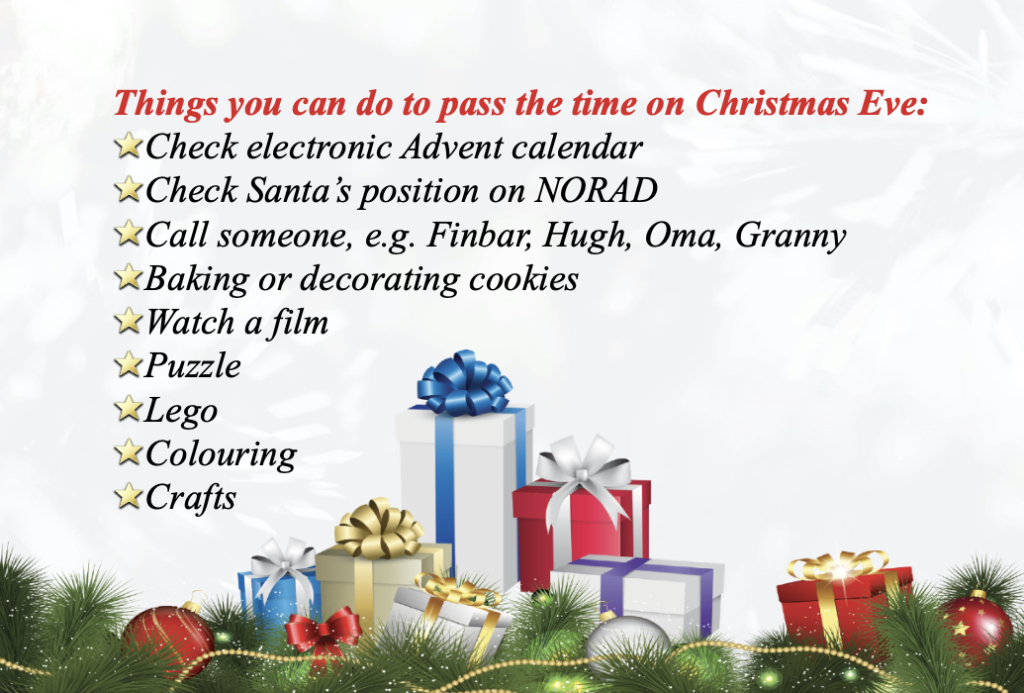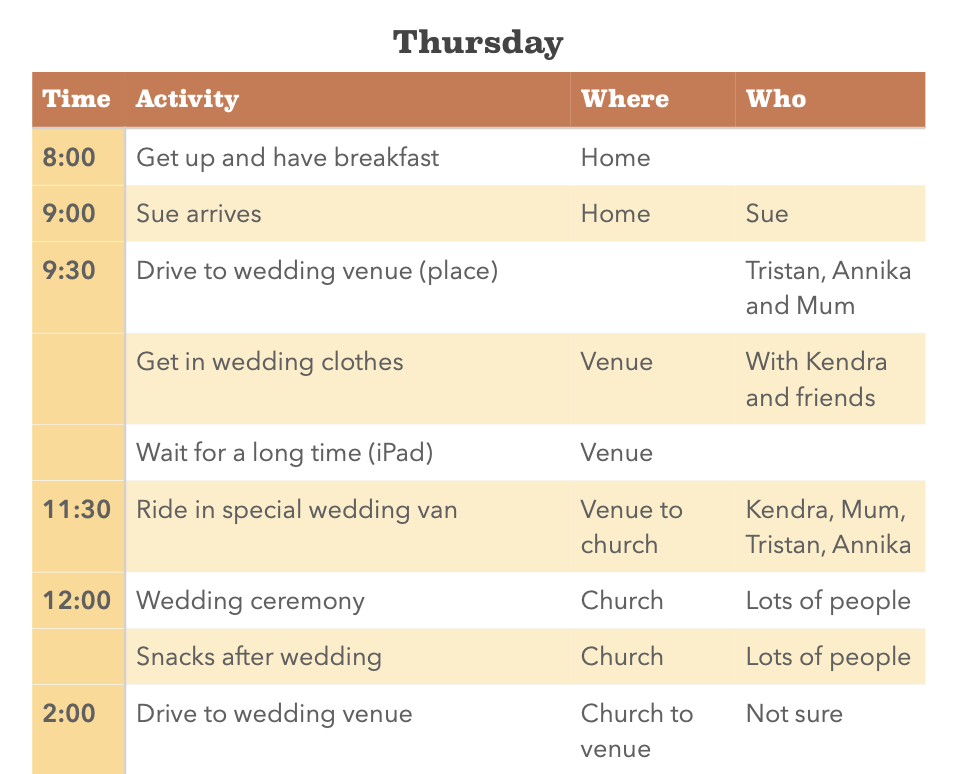PREDICT Guides for Activities and Special Occasions

Improving the predictability of special occasions.
It’s Christmas time again, and as with every year, I am hearing everywhere about how much autistic people hate Christmas. My family, almost all of us autistic, are atypically atypical this way. We love Christmas! One thing our family quite like about Christmas is the predictability. “Predictability??” You heard me right. Christmas is the only time of year where for two days we know exactly what we will eat, what we will do, what music we listen to, and who we’ll spend time with. It even gives an acceptable topic of conversation in most settings. For more detail on this, see my separate Christmas post.
This predictability depends on consistency in routines and traditions, and the ability to remember those from one Christmas to the next. Some people have difficulty committing these things to memory, and some things, unlike Christmas, are one-of-a-kind (e.g. holidays, weddings). This can lead to an autistic or anxious family member asking repeatedly what will be happening and when. In a moment of enlightened self-interest, I started making guides for special occasions.
Benefits of a PREDICT Guide
PREDICT Guides include information that help to make special events more predictable. Why should you consider making one for a neurodivergent person in your life? Being predictable:
- Prediction reduces anxiety that can arise from uncertain situations. Many autistic people reduce uncertainty by having a strict routine. When that routine is disrupted by a major event, uncertainty takes its place. Increasing the predictability of an event will reduce this anxiety.
- Consistent information can reduce repetitive questions. In an uncertain situation, sometimes repetitive questions are a means of testing whether the answers are the same or reassuringly predictable. You can redirect questions to the guide, which will always give the same answer.
- From the other point of view, it can reduce time spent on repeating instructions, allowing the creator to get on with other tasks.
- Information about activities can help the disorganised to prepare and get what they need in order.
- Learning about the things that are due to happen, and reducing anxiety may even, if we’re lucky, allow some of that anxious energy to be channelled towards excitement.
These guides have similarities to Social Stories (TM), but they are structurally quite different, they are aimed at a more sophisticated audience, they are usually for special events rather than regular day-to-day things, and they may have no social element at all. The emphasis is on helping the neurodivergent reader to cope with a situation by giving the information they need to understand and predict what will happen more accurately.
Making a PREDICT Guide
To help you know what to include, I’ll use the acronym PREDICT. This should be its own reminder that the point is to make things predictable. PREDICT stands for:
- Preparation
- Resources
- Expectations
- Directions
- Illustrations
- Choices
- Timetable
If you are going to try this it is essential that you stick as closely as humanly possible to the things that are in it. Include things that might happen as flexible events, but making a guide and then not following it will just make everything worse. If you have people who might drop in, the possibility that they will come should be included. If you can nail them down to a day, so much the better.
Preparation
The point of the guide is to prepare someone for what will happen and to make it predictable. If they need to do something to prepare, include that. Some cases may include a to do list that can be ticked or crossed off. You can also include things that they may want to do to prepare.
Resources
Include links to websites about your destination or type of event, and include information needed for getting help if it is needed. Packing lists (part of ‘preparation’) can also be considered a resource.
Expectations
Expectations can be both what the reader should expect to happen (the main overall point of the Guide) as well as what is expected of them. Are there special rules that will be in place where you are? Most important are those rules that are different from normal life. You may want to include what to do about things that may be challenging. Include what you are doing to help and what they can do for themselves.
Directions
If it’s important to the event you are documenting, include a map. You can put your route on it if you are travelling. Directions can also be instructions, like how to get into a building, security procedures, or a travel itinerary.
Illustrations
Fill in empty space with pictures. For those who don’t read as well or who benefit from pictures along with words, use these more. Only use photos if they are of the actual place or people. It is possible to go overboard with photos so they end up confusing, but pictures of entrances, seating areas and things or people the person is likely to interact with are most helpful. Some really appreciate pictures of people they will meet, but others aren’t interested enough in people for that to matter much to them. It’s very individual.
Choices
Include any things they will have to choose from if they are known in advance. My Christmas example includes things they can choose to do if bored on Christmas Day. Many autistic people find choosing itself to be difficult so having an idea of the options in advance can be very helpful. If you’re going away and can’t take everything they might want to, include some choices for packing, like 2 favourite toys out of a list of possibilities.
Include the things you will definitely do in a specific order in the timetable (see below, but those things that are more flexible can just be given as a list of possibilities. This is especially useful if the person can choose for themselves what they might do. If you’re going to a theme park and there are many rides they might do, include some options of what they might choose to do. Some choices you may want to consider (plus your own, depending on the type of activity):
- Food/menu, which can be very important if the food is different from normal. For those with food anxiety, include an explicit statement that no one will make them eat anything they don’t want.
- Things to pack (especially if limited)
- Things to do if bored, especially if they are away from home or prevented from doing their usual things.
- Choices of activities or outings

Timetable
Include a list of expected events. Remember to keep them relevant to the reader. You don’t need to tell them about things they’re not involved with. Also avoid my error. In the wedding guide I had a timetable like this:

This includes a critical error. At 11:30am, we were not in the special wedding van we were still putting the finishing touches on clothes and flowers. This led to an anxious small boy getting rather concerned about the discrepancy. Since then, I have been a lot more careful about when I commit to specific times, and the timetable looks more like this:

A sequence of events is essential for most situations that would need a PREDICT Guide, but only include a level of detail you are absolutely certain of. Drifting from a stated time is worse than not giving a time at all. So if you’re going on holiday, you may know for certain what day you’re going, and you may have a planned time to leave, but unless you are sure you could not possibly leave later – flight delays and flat tyres happen – don’t say exactly what time it will be. Those who can understand about such changes may appreciate guide times without getting too attached to them.
Other things to consider
You might like to include a few other things:
- How they can tell you if there is a problem, or what should be done about a problem if it comes up.
- What questions they might have, and answers to them.
- A packing list. This can be for them to follow while packing, or it can be reassurance that their important things will be coming (e.g. if moving house).
- Links to sites about the places you will go.
- Contact information for how to get help (e.g. how to text a family member). Even if they already have it, put it in the guide so it’s convenient.
Make sure to include the basics, like where and when, but also exactly what this is all about. If it’s a wedding, who is getting married? What is the reader’s role? If it’s a holiday, what is the place like and why would you want to go there? Include things you might think are obvious. Remember to include how the event will end. Will you come back home, will it be on a certain day, will something else happen to replace it?
How will you publish it? You can print it or put it on an electronic device if they already have one.
In order to be clear, you may need to skip some detail. Include details that help with working out what is likely to happen (prediction is the point). It should be very specific about what it’s for and not try to cover too many things in one guide. You can make one for starting at a new school, but you can’t make a guide in this format that would cover school in general. You can make one for a specific event.
Examples
Here are some that I’ve done for my family:
The Autscape handbook is the same idea on a larger scale. This covers the Rules and Empowerment aspects a lot more thoroughly than our family examples do.


